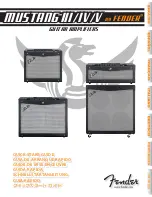
Page 41
CE-Series
Amps with an Attitude!
R
LVA
BIAS
CURRENT
SOURCE
–VCC
+ HI-VOLTAGE
BOOTSTRAP
BIAS
BIAS
BIAS
BIAS
BIAS
TDVI
LIMITER
TRIPLE-DEEP
DARLINGTON
NPN POSITIVE
OUTPUT STAGE
TRIPLE-DEEP
DARLINGTON
NPN NEGATIVE
OUTPUT STAGE
PROPORTIONAL
SPEED
FAN
CONTROL
FAN
DC
PROTECT
HEATSINK
TEMPERATURE
OUTPUT
CONTROL
HEATSINK
TEMPERATURE
TRANSFORMER
TEMPERATURE
TO FAULT
INDICATOR
POWER
SUPPLY
+ VCC
+ 15V
– 15V
– VCC
TURN-ON
DELAY
+
OUTPUT
BOOTSTRAP
CIRCUIT
+ HI-VOLTAGE
BOOTSTRAP
The signal next enters the main amplifier error amp where it is
mixed with a small portion of the output signal in such a way as
to control the amplifier’s overall output performance.
Warning:
Details of closed loop amplifier design are beyond the scope
of this description and if discussed, would surely put most
readers to sleep!
Following the error amp is the LVA stage, which is where the
low-voltage referenced signal gets translated to the output
high-voltage rails. The last voltage amplifier, in conjunction with
a bootstrapped current source, drives both predrivers and the
bias servo. The bias servo is mounted in such a way as to
translate the output heatsink temperature into a controlled bias
current to prevent thermal runaway and hold the amplifier’s
notch distortion to a minimum.
The predrivers provide enough signal to activate the drivers,
which together operate in the class AB range. For the major
output current requirements, the drivers feed the various num-
bers of paralleled output transistors which operate in a class B
mode. This we call the Triple-Deep Darlington Output Stages.
The output transistors are protected by the Time Dependent
Summary of Contents for CE 2000
Page 5: ...Page 5 CE Series Amps with an Attitude ...
Page 13: ...Page 13 CE Series Amps with an Attitude ...
Page 20: ...Page 20 CE Series Amps with an Attitude ...
Page 22: ...Page 22 CE Series Amps with an Attitude ...
Page 34: ...Page 34 CE Series Amps with an Attitude Fig 4 4 Unbalanced Input Wiring ...












































